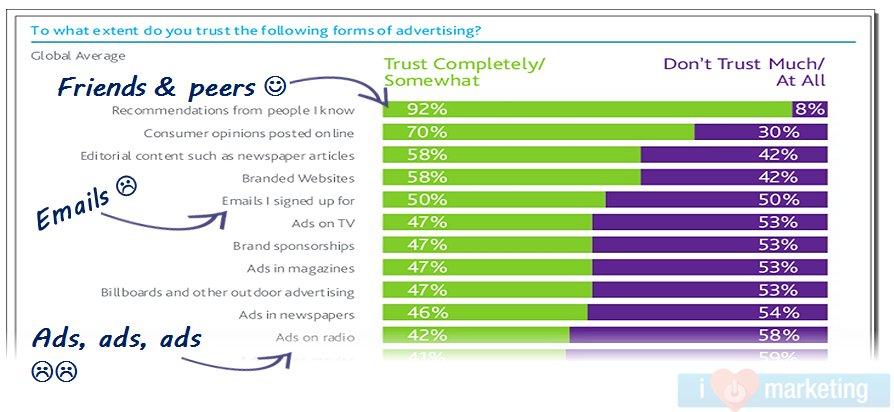If you’re not taking advantage of advocacy marketing (aka influencer marketing, referral marketing, and word-of-mouth marketing), you should give it serious consideration. Here are a few reasons:
- According to McKinsey & Company, word-of-mouth (WOM) is the primary factor behind 20%-50% of all purchasing decisions.
- A Zubrance white paper states that for every $1 a company invests in energizing its brand advocates, it receives $10 in positive WOM impressions and sales.
- MathMarketing did a study that showed marketers who use referral marketing have higher marketing-qualified lead (MQL) closure rates than those who use purchased lists.
- BzzAgent says brand advocates are:
- 75% more likely to share a great experience about a product.
- Prolific content creators; they write and share more than 2X as many online communications about brands than do non-advocates.
- 70% more likely to be seen as a good source of information by people around them.
Advocacy marketing has bubbled up with vengeance this year, but the practice isn’t new – leveraging WOM amplification from influential people who like you (they really like you) is probably one of the oldest marketing techniques in the book. But since everything old is new again (I’m talking to you, pork pie hats), advocacy marketing is back in the spotlight, heralded by digital pundits as an essential technology-aided marketing strategy that can deliver big upside.
History and the above data points suggest they’re right. This post – part 1 of 2 – will attempt to tie a bow around the business case. (Part 2 will dive into the how-to’s and offer a few case studies.)
First things first …
What is Advocacy Marketing?
Advocacy marketing is a strategy for motivating your most important marketing assets – e.g, happy customers, employees, partners, and fans – to spread the word about your company, products, and services via their networks and communities.
It’s always been a powerful practice, and it’s more so now thanks to the digital age and, in particular, the rise of social media. With modes spanning recommendations, ratings, reviews, testimonials, answers to forum questions, comments, and shares, today’s advocacy marketing is more immediate and more scalable than ever in history.
There are three types:
 Earned Advocacy. This is the most valuable type because the source is authentic – actual customers, industry thought leaders, and influencers. It’s also the most scalable because it’s self-perpetuating: as you fill the funnel with new leads and gain new customers, the advocacy process begins anew. Additionally, earned advocates are more likely than others to be content creators – people who generate content that references, touts, and/or links back to yours.
Earned Advocacy. This is the most valuable type because the source is authentic – actual customers, industry thought leaders, and influencers. It’s also the most scalable because it’s self-perpetuating: as you fill the funnel with new leads and gain new customers, the advocacy process begins anew. Additionally, earned advocates are more likely than others to be content creators – people who generate content that references, touts, and/or links back to yours.
Like “earned media,” earned advocacy is not paid for … at least not directly (there’s a lot of hard work involved in providing great products, services, and storytelling that lays the groundwork), and it can’t be bought. It can be effective through the entire funnel.
 Owned Advocacy. Owned advocates are “inside players” who are associated with your brand and have a stake in its success; e.g., employees, fellow travelers, suppliers, and business partners. Its value can be important in the middle and bottom of the funnel when prospective buyers are diving deeper and looking for more specific proof points and engagement levels on which to base their decisions.
Owned Advocacy. Owned advocates are “inside players” who are associated with your brand and have a stake in its success; e.g., employees, fellow travelers, suppliers, and business partners. Its value can be important in the middle and bottom of the funnel when prospective buyers are diving deeper and looking for more specific proof points and engagement levels on which to base their decisions.
Paid Advocacy. Like the term, these are advocates a company pays to endorse the brand. Celebrities and athletes fall into this camp, as do doctors, lawyers, and other influencers who are remunerated in exchange for their seal of approval. Although they’re far less likely to be viewed as authentic, paid advocates can help jumpstart awareness and interest for a product or service.
Why is It Valuable?
Economics.
Advocacy marketing is based on the data-supported premise (the bullets that introduce this post, for example) that buyers are heavily influenced by their peers and, in fact, have higher trust in the information supplied by people they know than in the information supplied by companies. And, the people actively listening are probably active buyers.
Here’s a graph that puts a fine point on it, sourced from Nielsen and presented at the 2014 i♥marketing conference:
Assuming your advocates spread positive WOM, advocacy marketing is a highly effective way to expand marketing reach and amplify what works without significantly increasing marketing costs. Key business benefits include increases in demand generation, traffic, qualified leads, revenue, and transaction size.
Not too shabby.
What Can Advocacy Marketing Be Used For?
There are many goals that can be met and/or supported by using advocate marketing. Here are four of them:
1. Revenue growth. Most advocacy marketing programs (earned, owned, or paid) are all about getting referrals – people who will visit you, engage with you, purchase from you, join forces with you. The larger your pool of advocates, the more opportunities you have to expand visibility, improve trust, and grow your revenue streams.
2. Demand generation. Advocates can be great champions for you at the top of the funnel by promoting you and your products, services, great experiences, content, events, offers, promotions, deals, coupons, etc. across their wide range of blogs and social networks.
3. Content marketing. Advocates tend to be prolific content creators (even paid advocates because they have a vested interest in your brand’s success). This means advocates are far more likely to proactively share your content. The more useful and relevant your stuff is to their networks, the better.
4. Product development. Developing a new product or service generally takes a lot of time, resources, and money, all of which can be reduced by tapping into your pool of advocates. Their quick feedback and insight into consumer needs and expectations can help you understand your ideal target customer and decrease the time-to-market.
Don’t be the 7 Percent
That’s the percentage of brands that offer only social customer incentives and rewards, even though 47% of us expect incentives and rewards when we connect with brands online (Lithium). True, advocacy marketing is more than social, but the data point illustrates a very real disconnect … and a very real opportunity to harness an underutilized strategy.
Advocacy marketing can give a welcome and measurable boost to the entire sales funnel. In Part 2 we’ll dive into how it’s done. Stay tuned …
“Share me” by pixelised, used under Creative Commons license.
“Exit Bear Stearns, Enter Grumpy Cat” by SFview, used under Creative Commons license.



